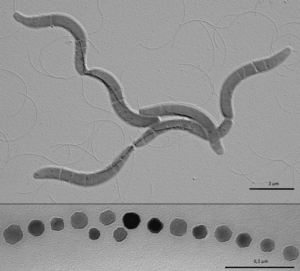Magnetotactic Bacteria: Difference between revisions
| Line 1: | Line 1: | ||
==Introduction== | ==Introduction== | ||
[[Image:M. gryphiswaldense.png|thumb|300px|right| Electron micrograph of Magnetospirillum gryphiswaldense cells containing chains of magnetite crystals (top) and magnified section of crystal chain (bottom). By Caulobacter subvibrioides (Diskussion) GFDL (http://www.gnu.org/copyleft/fdl.html)], via Wikimedia Commons]] | [[Image:M. gryphiswaldense.png|thumb|300px|right| Electron micrograph of Magnetospirillum gryphiswaldense cells containing chains of magnetite crystals (top) and magnified section of crystal chain (bottom). By Caulobacter subvibrioides (Diskussion) GFDL (http://www.gnu.org/copyleft/fdl.html)], via Wikimedia Commons]] | ||
< | <i>Magnetospirillum gryphiswaldense</i> (also referred to as MSR-1) is a gram negative magnetotactic bacteria that is found in shallow fresh water and sediment. They are characterized by a spirillial morphology with flagella at each end of the cell. They are able to orient themselves based on Earth’s magnetic field (magnetotaxis) due to special organelles called magnetosomes. | ||
<br><br>Other examples: | <br><br>Other examples: | ||
<br><b>Bold</b> | <br><b>Bold</b> | ||
Revision as of 00:04, 24 March 2015
Introduction

Magnetospirillum gryphiswaldense (also referred to as MSR-1) is a gram negative magnetotactic bacteria that is found in shallow fresh water and sediment. They are characterized by a spirillial morphology with flagella at each end of the cell. They are able to orient themselves based on Earth’s magnetic field (magnetotaxis) due to special organelles called magnetosomes.
Other examples:
Bold
Italic
Subscript: H2O
Superscript: Fe3+
Section 1
Include some current research in each topic, with at least one figure showing data.
Section 2
Include some current research in each topic, with at least one figure showing data.
Section 3
Include some current research in each topic, with at least one figure showing data.
Conclusion
Overall paper length should be 3,000 words, with at least 3 figures.
References
Edited by student of Joan Slonczewski for BIOL 238 Microbiology, 2009, Kenyon College.
